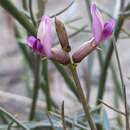Comprehensive Description
provided by North American Flora
Pterophacos pterocarpus (S. Wats.) Rydberg
Astragalus pterocarpus S. Wats. Bot. King's Expl. 71. 1871. Tragacantha pterocarpa Kuntze, Rev. Gen. 947. 1891.
A perennial, forming clumps; stems several, decumbent at the base, branched, 3-5 dm. high, striate, sparingly strigose; leaves ascending, strigose, 5-10 cm. long, the rachis margined; stipules deltoid, 4-5 mm. long; leaflets 5-9, linear-filiform, similar to the rachis and indistinctly jointed to it, 2-5 cm. long, about 1 mm. wide, strigose, caneseent when young; peduncles 8-15 cm. long; racemes 3-5 cm. long; bracts lanceolate, 1-2 mm. long; pedicels 2 mm. long; calyx pilose, usually with mixed white and black hairs, the tube 7-8 mm. long, 2.5-3 mm. broad, the teeth subulate, 2 mm. long; corolla purple, 15-17 mm. long; banner obovate, moderately arched; wings 12-13 mm. long, the blade obliquely oblanceolate, falcate, with a large reflexed auricle; keel-petals slightly shorter, the blade oblong, falcate, with a large reflexed auricle; pod obeompressed, oval-ovate or lanceolate in outline, 3.5-4 cm. long, 15-18 mm. thick, and 3 mm. wide, the sutures rather prominent but not winged, except at the apex, the pod depressed around the sutures, the cross-section resembling a pair of spectacles.
Type locality: Junction of Reese River with the Humboldt, Nevada.
Distribution: Nevada.
- bibliographic citation
- Per Axel Rydberg. 1919. (ROSALES); FABACEAE; PSORALEAE. North American flora. vol 24(1). New York Botanical Garden, New York, NY
Physical Description
provided by USDA PLANTS text
Perennial, Herbs, Stems woody below, or from woody crown or caudex, Plants with rhizomes or suckers, Nodules present, Stems erect or ascending, Stems less than 1 m tall, Stems solid, Stems or young twigs sparsely to densely hairy, Leaves alternate, Leaves petiolate, Stipules conspicuous, Stipules membranous or chartaceous, Stipules persistent, Stipules free, Leaves compound, Leaves odd pinnate, Leaf or leaflet margins entire, Leaflets opposite, Leaflets 5-9, Leaves hairy on one or both surfaces, Inflorescences racemes, Inflorescence axillary, Bracts very small, absent or caducous, Flowers zygomorphic, Calyx 5-lobed, Calyx hairy, Petals separate, Corolla papilionaceous, Petals clawed, Petals blue, lavander to purple, or violet, Petals bicolored or with red, purple or yellow streaks or spots, Banner petal na rrow or oblanceolate, Wing petals narrow, oblanceolate to oblong, Wing tips obtuse or rounded, Keel petals auriculate, spurred, or gibbous, Keel tips obtuse or rounded, not beaked, Stamens 9-10, Stamens diadelphous, 9 united, 1 free, Filaments glabrous, Style terete, Style persistent in fruit, Fruit a legume, Fruit unilocular, Fruit freely dehiscent, Fruit oblong or ellipsoidal, Fruits winged, carinate, or samaroid, Fruit fleshy, Fruit coriaceous or becoming woody, Fruit exserted from calyx, Fruit beaked, Fruit glabrous or glabrate, Fruit 11-many seeded, Seeds cordiform, mit-shaped, notched at one end, Seed surface smooth, Seeds olive, brown, or black.

